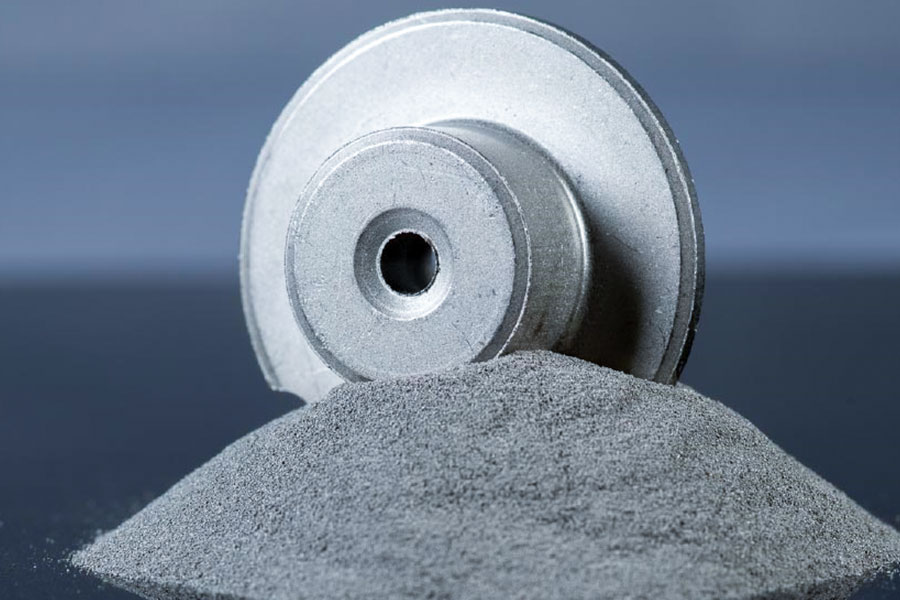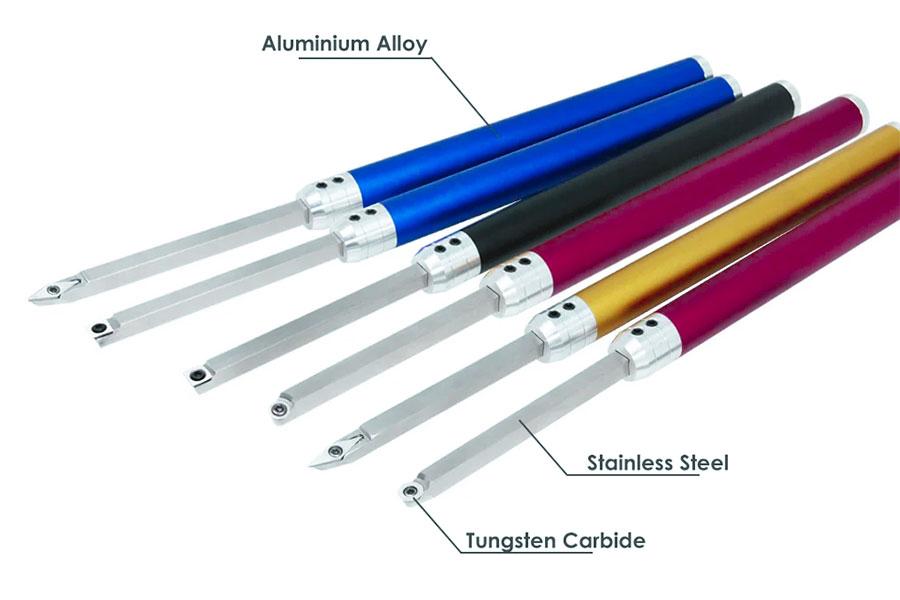Woodturning, as woodwork, when the turning wood blank is shaped into smooth curves and lean profiles beneath the fingertips, the turning tool is the far and away most sensitive extension of our fingers. But it is not just the shape of the blade which gives this "extension" spirit and strength, but the steel deep inside. Its personality, being a silent maestro, predominantly determines whether the blade shall be capable of slicing through the acute edge of wood fibers in an instant, whether it shall be able to bear the brunt of prolonged usage, and eventually, whether it shall leave a silky pure and spotless finish on the surface of your work.
But with a dazzling array of choices and the fog of technical terms such as HSS, carbide, and M42, many amateur woodturners can't help but be confused: What steel is suited for my turning piece de resistance? Which will perfectly harmonize with my studio rhythm and taste? Burying beneath the bewildering choices is a refined trade-off between performance, price and craftsmanship.
No more feeling around in the dark. In this report, I will offer you a straightforward comparison of the mainstream favourite steel types used in woodturning tools - close look at their basic traits, key advantages and potential flaws. We'll remove the perplexing shroud of jargon so that you may make an informed and confident choice on real work needs, cost and your own turning style, so the best steel will be a reliable source of strength for your creative work.
Comparison Of Fundamental Properties Of Types Of Turning Tool Steels
| Steel type | Core properties | Best use | Ease of sharpening | Edge retention |
|---|---|---|---|---|
| High-speed steel (HSS) | The all-around workhorse | All-round turning (both rough and fine), fine finishing, traditional shaping (e.g., bowls, shafts, etc.). | Easy (Effectively grinds with a standard bench grinder) |
Good |
| Carbide | The king of durability | Roughing (especially efficient), turning abrasive materials (e.g., resin-impregnated wood, hardwood, sandy/gum wood), beginners who are not good at sharpening or want to be maintenance-free for a long time. | Difficult (It is usually more cost-effective to replace the blade, or fine grinding with diamond grinding tools, which is difficult to effectively grind with ordinary grinders) |
Excellent |
| Powder metallurgy steel (PM Steel) | The top performance choice | Advanced players and professional applications who want the ultimate edge retention without sacrificing sharpness. Suitable for long-term fine turning and work that requires extremely high surface finish. | Medium (Requires specific grinding wheels (such as ceramic grinding wheels/CBN grinding wheels) to achieve the best results, more demanding than high-speed steel, but easier than carbide) |
Exce |
The All-around Workhorse: High-Speed Steel (HSS)
| Features | High Speed Steel (HSS - M2) |
|---|---|
| Material | High Speed Steel (mainstream grade M2) |
| Key Benefits | Can be sharpened to an extreme edge for clean cuts and excellent surface finish |
| Edge retention | Moderate (not as good as carbide) |
| Toughness | Excellent (impact and chip resistance) |
| Easy to sharpen | Very high (easy to grind on a standard bench grinder) |
| For woodturners | who pursue a perfect finish and enjoy tool maintenance |
High-speed steel (HSS), and most especially the M2 grade, is the unbeaten mainstream material for traditional woodworking turning cutlery. Its inherent worth is the following:
Outstanding sharpness and fine finish: The most obvious advantage of HSS is that it can be sharpened to a "razor-sharp" cutting edge. This outstanding sharpness is the foundation for achieving an extremely clean and smooth surface on wood, with a good foundation for additional processing (e.g., grinding), and is the turner's preferred option who desires ideal surface effects.
Enhanced toughness: Compared to its harder but more brittle rivals such as cemented carbide, HSS has enhanced toughness. This means that the cutting tool is less likely to chip and splinter when it encounters hard knots, coarse grain in the wood or minor impacts in use, which increases the life of the tool and safety in use.
Unbeatable convenience for sharpening: The most practical advantage of HSS is that it is extremely convenient to sharpen and trim on a standard bench grinder. Turners can simply and rapidly hone the tool back to sharpness without the necessity of expensive professional tools or complex protocols. The low maintenance renders the threshold of use and the cost of long-term use significantly low.
Balanced sharpness retention: Although HSS is not as long-lasting as carbide when it comes to sharpness retention, it is sufficient for general woodturning purposes and fairly acceptable. Much more important, though, is that it possesses excellent sharpening characteristics that more than make up for this lack, with edge maintenance being readily and quickly done.
High-speed steel (HSS) is the best general favorite among woodturners who like to work with quality and are not averse to hand-sharpening their tools, with its ideal finish owing to ultimate sharpness, acceptable impact toughness, and above all, excellent sharpening characteristics on general-purpose grinders.
Indestructible Blade: Tungsten Carbide
In woodturning lathes, carbide turning tools are the latest best thing due to their unique performance, especially among hobbyists. In order to get a good appreciation of how it compares to antiquated high-speed steel (HSS) turning tools, we first introduce the main comparison in a table:
| Features | Tungsten Carbide | High-speed Steel (HSS) |
|---|---|---|
| Material Composition | Composite (Tungsten Carbide Particles + Bonding Metal) | Special Alloy Steel |
| Common Form | Steel Tool Bar + Replaceable Small Blade | Solid Steel Tool |
| Core Advantages | Superior Sharpness Retention | Superior Sharpness Retention |
| Applicable Scenarios | Hardwood, Resin/Grit Wood, Long-term Continuous Turning | General Wood, When Fine Edge Shape is Required |
| Main Disadvantages | Brittle and Easy to Chip; More Like a Scraping Tool Relatively | Easy to Wear, Needs Frequent Sharpening |
| Passivation Treatment | Rotating Blade Uses New Edge or Directly Replaces Blade | Requires Re-sharpening (Maintains Specific Profile) |
| Operational Characteristics | Sensitive to shock and improper use | Relatively impact-resistant, allows certain cutting angles |
1. Form and structure:
Carbide is not a single metal, but a blend, which is sintered with extremely hard tungsten carbide grains and metal binders such as cobalt.
Standard carbide turning tools usually employ modular design: a steel tool bar solid in construction, the front end of which is clamped with a small, expendable carbide blade in a mechanical manner (with screws, pressure plates, and slots). This design reduces highly the tool management and application complexity substantially.
2. Core strengths: unequalled retention of sharpness:
This is carbide's "superpower" that it boasts most about. Its hardness is significantly greater than HSS, so it is extremely wear-resistant.
Facing difficult materials that will readily dull HSS tools - hardwoods (such as rosewood, mahogany), resinous woods (such as pine), or gravel-infested woods - carbide blades can shear hour after hour and still maintain useful cutting (better said, scraping) capabilities.
For new operators or operators performing lengthy operations on the lathe, this translates into less downtime and more uniform processing results with fewer interruptions necessary to sharpen the tools.
3. Main Drawbacks and Characteristics:
Brittleness: The flip side is that over-hardness brings about brittleness. Carbide blades are not impact-resistant and poorly handled. When you cut the wood at the wrong angle, strike a hard knot or knot, or get knocked solidly, the blade is easy to chip, unlike curling or wearing away like HSS.
Scraping Nature: Carbide tooling is more "scraping" than "cutting" in the traditional sense. It will scrape out the wood with its hard edge rather than cutting it with smooth shearing cuts like a very sharp HSS. This will affect the quality of the final surface finish and nature of the operation (though good results can still be achieved once proficiency has been gained).
4. Passivation and Maintenance:
As soon as carbide cutting tools are worn or chipped, it is very impractical and hard to re-grind them to a specific profile because of their very high hardness, the need for grinding wheels of diamond type, and high technical demands.
The advantage of its modular construction is illustrated here: the simplest solution to a dull blade is to reverse the blade and move the unused sharp edge to the operating position, or replace a new blade. This makes maintenance extremely rapid and simple, especially for those who do not want or are not currently able to master complex sharpening techniques.
Its revolutionary sharpness retention, carbide turning tools provide turners, especially new turners, with a key tool for dealing with hardwood and abrasive wood, mostly eliminating the inconvenience of sharpening; its own brittleness and scraping properties, though, require that users get skilled in proper operating techniques so as not to chip and to accept its special processing methods. Simple replacement of blades or blades following passivation is the gist of maintenance benefit provided by its design.
HSS vs. Carbide: Which One is Right for You?
PM steel vs. HSS vs. carbide key properties comparison
| Properties | Powder metallurgy (PM) steel (e.g. M42, V10) | High speed steel (HSS) | Carbide |
|---|---|---|---|
| Grain structure | Very fine, highly uniform | Relatively coarse, with potential for segregation | Very fine (hard phase matrix) |
| Sharpness | Approximate to HSS | Very high | Relatively low |
| Wear resistance | Approximate to carbide | Low | Very high |
| Toughness | Medium (better than carbide) | High | Low |
| Cost | Highest | Low | Medium |
| Main users | Experienced professionals, enthusiasts | Wide range of users | Seeking efficiency, mass production |
The Icing On The Cake: The Role Of Cryogenic Treatment
In order to clearly understand the impact of cryogenic treatment on woodworking tool steel (such as HSS, PM steel), the key characteristics are compared in the following table:
| Characteristics | Cryogenically treated | Untreated |
|---|---|---|
| Grain structure | Significantly refined and more uniform (retained austenite transformation) | Relatively coarse, retained austenite may exist |
| Wear resistance | Significantly improved | Standard level |
| Toughness | Improved (reduced micro stress, brittleness) | Standard level |
| Edge retention | Significantly better (wear resistance + toughness work together) | Standard level |
| Application positioning | High-end, top brand (value-added characteristics) | Mainstream, standard products |
1. Process principle:
Cryogenic treatment is a process that cools steel to an extremely low temperature (usually below -185°C / -301°F), keeps it at this temperature for a sufficient time, and then returns to room temperature very slowly and in a controlled manner.
Its core goal is to promote the conversion of retained austenite (Retained Austenite) that may still exist in the steel after conventional heat treatment (quenching + tempering) into harder and more stable martensite (Martensite) as much as possible and stably.
2. Core advantages: grain refinement and structural stability:
Through deep low-temperature transformation and slow temperature recovery, cryogenic treatment can further refine the microscopic grain structure of steel and make it more uniform and dense.
This structural optimization is the basis for improving the comprehensive mechanical properties of materials (especially wear resistance and toughness).
3. Performance improvement: a win-win situation of wear resistance and toughness:
Significantly improve wear resistance: Finer and more uniform grain structure directly means that the material's ability to resist wear (such as friction loss of hard particles in wood and resin on the cutting edge) is greatly enhanced. This is a key factor in improving sharpness retention.
Improving toughness: Cryogenic treatment helps to release micro stress, reduce grain boundary brittleness, and improve the toughness of steel while maintaining high hardness. This makes the cutting edge of the turning tool less likely to break or fracture when subjected to impact (such as when turning hardwood knots and irregular textures), further extending the effective sharpness life.
4. Importance and location of woodworking turning tools:
In the case of woodworking turning tools (turning tools, scrapers, etc.), the direct benefit of cryogenic treatment is "sharpness retention is improved to a higher level". That is, under the same conditions of usage, the cutting edge of HSS or PM steel turning tools which are cryogenically treated can maintain sharpness and effective cutting time much longer than the same untreated products.
Due to its process cost and complexity, cryogenic treatment is typically an upscale feature that "adds icing to the cake". It typically comes in high-end products and professional tools that desire best-in-class performance and longer life. It is one of the major signs to distinguish high-end products.
Cryogenic treatment enhances the microstructure of steel through deep low-temperature transformation, significantly improving wear resistance and toughness of high-grade HSS or PM steel woodturning tools, making their edge retention far superior to conventionally treated tools, and can be said to be a "performance sublimator" for high-level tools.
Case Summary: Manufacturing Innovation Of Complex Wooden Artwork
1. Customer challenge:
We encountered a wood artist who developed a set of very detailed wooden vases using imported hardwood with a high resin content. Material characteristics (high hardness and high resin content) were very difficult to the processing tools: the carbide turning tool soon became passivated and was destroyed, and the high-speed steel turning tool was slightly better, but the machined surface was very rough, resulting in a great deal of time and effort for heavy hand grinding, which significantly affected production efficiency and quality of finished parts.
2. Limitations of traditional solutions:
Faced with such demanding materials, the traditional course of action is for the artist to pay a high cost to purchase a set of good powder metallurgy high-speed steel turning tools, and incur substantial amounts of time on personal skill acquisition (exercise) and tool upkeep (sharpening) in order to address the task of material processing. Not only time-consuming and costly but with unpredictable outcomes as well.
3. LS's innovative solution:
In-depth analysis: The designer uploaded the 3D design model of his vase into our web-based collaboration platform. Our engineer group carefully examined the geometric complexity, most dominant features and processing difficulties of the design.
Material optimization suggestions: Based on analysis findings and a solid grasp of material characteristics, we didn't limit ourselves to the traditional tool upgrade ideas, but stepped into new territory by innovatively suggesting a high-performance wood-plastic composite material as a replacement. Not only can this material faithfully replicate the complex shape of the design, but what's more important, it has stable performance and is easy to process, which is particularly well-adapted to CNC precision processing.
High process of manufacturing: Lastly, the vases' shape is formed by our 5-axis CNC turning center. The strength of 5-axis linkage ensures that even such complex surfaces can be replicated precisely, and the excellent processing properties of the new material can be maximally utilized.
4. Excellent results:
Perfect reproduction of geometry: The complex vase structure is perfectly manufactured by CNC machining, and the geometry is impeccable.
Top-notch surface quality: With the optimum material and advanced CNC process, the end product has a good surface finish, greatly reducing or even completely removing the necessity for subsequent manual polishing.
Significant increase in efficiency: The entire production process is efficient, controllable and replicable, and the production efficiency has made a qualitative jump.
Customer value focus: The artists are freed from the weighty and technologically challenging hand-turning and polishing, and can invest their precious energy on their forte - design creativity and market strategy. The complex and high-precision "turning" manufacturing process is left to the security of our industry-grade precision manufacturing ability.
5. LS's value embodiment
This case is a typical illustration of how LS solves customers' pain points in treating challenging and special materials through the integration of engineering analysis, material science, and sophisticated manufacturing technology. We not only provide equipment, but also total process optimization solutions to help customers surpass the confines of traditional approaches, achieve overall improvement in quality, efficiency, and cost-effectiveness, and allow customers to focus on creating more core value.
FAQs
1. Will a metalworking HSS turning tool work for turning wood?
Yes, but with unsatisfactory results, as the grinding angle and geometry of metalworking turning tools are designed especially to cut metal and have large rake and relief angles and blunt cutting edges, while woodworking turning tools are made to cut wood fibers and have sharper cutting edges and special grooves to minimize tearing and improve finish. Wood turning with a metal turning tool made from metal can easily lead to fiber tearing, rough surface, jamming of the tool or tool wear quickly, affecting processing quality and efficiency. Therefore, it is recommended to use a specialized woodworking turning tool, such as high-speed steel or carbon steel, for smooth cutting and a finer finished product.
2. Why are carbide blades so expensive?
The reason for the high price of carbide blades is their manufacturing process: they must first prepare high-purity tungsten carbide powder and then shape it into a hard, precision blade through high-temperature and high-pressure sintering technology. It is an energy-intensive and technically challenging process with stringent temperature control and mold design. Raw material cost, equipment investment, and strict quality control also push the price up, but the blade's excellent properties, such as extremely high hardness, wear resistance, and long life, make it worth paying for in effective processing, especially in industrial mass production.
3. How can I tell if my HSS turning tool is sharpened?
One simple, effective testing method is to take a softwood and, with a turning tool, lightly cut the end: if it will cut a complete, paper-thin chip without tearing fibers or forming burrs, the edge is sharp enough. This test depends on the cuttability of softwood, and dullness will be indicated by chip breakage or surface damage; also, ensuring that the turning tool is sharpened to the correct angle, such as having the correct rake angle, can increase the validity of the test. Performing this test occasionally can optimize tool performance and reduce processing errors.
4. Is it worthwhile to spend more money on PM steels such as M42 or V10?
For professional machinists doing high-intensity turning every day, or serious amateurs who on a regular basis machine abrasive materials such as hardwood or composites, yes, it is worthwhile to spend more. Powder metallurgy steels such as M42 or V10 possess improved hardness and toughness because of advanced processes, and their wear resistance is considerably better than that of conventional high-speed steel, which can reduce frequent grinding and extend tool life, thus saving a tremendous amount of time and maintenance expenses in long-term application. Although the initial investment is large, its performance return is very substantial in terms of efficiency improvement and quality of processing
Summary
Exploring the characteristics of HSS, carbide and PM steel, we understand that "best" is never absolute. It depends on your current goal - the ultimate smooth surface, indestructible durability, or top comprehensive performance. Each type of steel shines with a unique light and serves different moments of craftsmanship.
However, when your woodworking works call for precision beyond manual work, when perfect repeatability becomes a necessity, and when the project moves towards large-scale production, the essence of the problem has been sublimated. At this time, the key to determining the final height and efficiency of the work is no longer just the steel of the turning tool in your hand, but the powerful manufacturing partner behind you.
In the face of these higher challenges, LS's CNC turning service is your indispensable ultimate "tool". It represents industrial-grade precision, unparalleled repeatability and efficient productivity, allowing your design ideas to be perfectly, consistently and efficiently realized. Choosing LS is to inject industrial-grade precision power into your extraordinary craftsmanship.
Upload your design drawings now and get an instant CNC turning quote (cnc turning price), let LS be your strong backing in pursuit of ultimate woodworking precision!
📞Tel: +86 185 6675 9667
📧Email: info@longshengmfg.com
🌐Website:https://lsrpf.com/
Disclaimer
The contents of this page are for informational purposes only.LS seriesThere are no representations or warranties, express or implied, as to the accuracy, completeness or validity of the information. It should not be inferred that a third-party supplier or manufacturer will provide performance parameters, geometric tolerances, specific design characteristics, material quality and type or workmanship through the LS network. It's the buyer's responsibilityRequire parts quotationIdentify specific requirements for these sections.Please contact us for more information.
LS Team
LS is an industry-leading companyFocus on custom manufacturing solutions. We have over 20 years of experience with over 5,000 customers, and we focus on high precisionCNC machining,Sheet metal manufacturing,3D printing,Injection molding,Metal stamping,and other one-stop manufacturing services.
Our factory is equipped with over 100 state-of-the-art 5-axis machining centers, ISO 9001:2015 certified. We provide fast, efficient and high-quality manufacturing solutions to customers in more than 150 countries around the world. Whether it is small volume production or large-scale customization, we can meet your needs with the fastest delivery within 24 hours. chooseLS technologyThis means selection efficiency, quality and professionalism.
To learn more, visit our website:www.lsrpf.com







